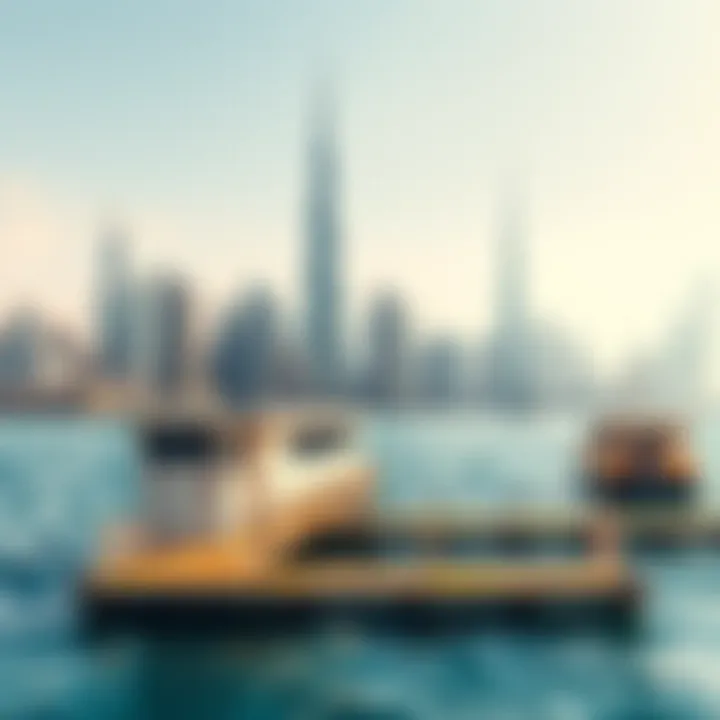Exploring the Dubai Ferry Route: A Comprehensive Guide


Intro
The Dubai Ferry service represents more than just a means of transportation; it is a vital artery connecting various parts of this vibrant emirate. From the bustling markets of Deira to the modern skyscrapers of Dubai Marina, these ferries provide an efficient means to navigate the sprawling urban landscape dotted with stunning waterways. Commuters and tourists alike utilize this service, benefiting from its speed and convenience.
With the emirate's push towards sustainable transport options and the desire to alleviate the heavy traffic on its roads, the ferry service stands out as a beacon of innovation and progress. Not only does it enhance connectivity, but it also offers passengers breathtaking views of Dubai’s skyline, which is especially captivating at sunset. This guide aims to embark readers on a journey through the key facets of this ferry service, discussing everything from operational routes, schedules, and tips for making the most out of this unique mode of transport.
Prelude to the Dubai Ferry Service
The Dubai Ferry service represents a significant addition to the intricate transport framework of the emirate, aiming to provide a seamless and efficient way to navigate the city’s stunning waterways. As Dubai transforms into a global hub of business and tourism, understanding the ferry service not only helps visitors make the most of their time but also allows residents to integrate ferry travel into their daily commutes. The unique perspective gained from traversing the waters enhances the travel experience and offers an ever-changing view of the city’s skyline.
Historical Background
The origins of the Dubai Ferry service can be traced to the early 2000s, coinciding with the rapid urban development within the emirate. Dubai's waterways, once primarily traversed by traditional dhows, began to evolve, leading to the introduction of modern ferry services in 2012. The objective was clear: to ease congestion on road networks and offer a scenic alternative for residents and tourists alike. The ferry service has matured since its inception, adapting to demand and expanding routes, making it an integral part of Dubai's public transport.
Interestingly, Dubai prides itself on its commitment to sustainable travel, and the ferry service embodies this philosophy by using eco-friendly vessels. Such innovations signify not only a shift toward modernity but also a cognizance of environmental impacts.
Purpose and Objectives
At its core, the Dubai Ferry service aims to achieve several objectives. First and foremost, providing an alternative mode of transport allows for enhanced connectivity between various districts like Bur Dubai, Dubai Marina, and Jumeirah. This connection is particularly valuable in reducing travel time for those living in waterfront communities.
Moreover, the ferry isn’t just about getting from point A to point B; it’s also about fostering a sense of community and showcasing the beauty of Dubai from a different perspective. The intention is to promote tourism by offering a unique view of the city's landmarks, from the majestic Burj Khalifa to the luxurious villas lining the coast. In doing so, the ferry service enhances the overall visitor experience while creating a sense of pride among residents about their vibrant city.
Indeed, the Dubai Ferry service acts as a catalyst for urban development, aligning with goals of sustainability, mobility, and aesthetic appreciation of the waterways and neighborhoods. As Dubai continues to grow, it becomes crucial for stakeholders and potential investors to understand the ferry service, recognizing its role not only in transportation but also in promoting urban enrichment.
Key Routes of the Dubai Ferry
The Dubai Ferry is not just a mode of transport; it is a journey that weaves through the rich tapestry of the emirate’s coastlines and cultural landmarks. Each route offers glimpses into the life and vibrancy of Dubai, making it essential for both residents and visitors. Understanding the key ferry routes helps in navigating not only the waterways but also the integration of various city elements.
Major Ferry Routes
Bur Dubai to Dubai Marina
The ferry from Bur Dubai to Dubai Marina is among the most celebrated routes, connecting two of the city’s most vibrant areas. The burgeoning skyline of Dubai Marina is a sight to behold, with its stunning architecture and luxury lifestyle.
This route offers travelers direct access to the marina’s cafes, shopping spots, and picturesque promenades, making it a popular choice for weekend outings. One notable characteristic is the smooth ride along the coast, providing views of upscale residential towers and commercial spaces that line the waterway. However, it’s essential to note that this route can get crowded during peak hours, which may affect the overall travel experience.
The unique feature here is the cultural contrast between the historical essence of Bur Dubai and the modernity of the Marina, making for a rich tapestry of impressions. The advantages of this route lie in its connectivity and scenic views, while its busy nature during certain hours can be a drawback for those seeking a tranquil experience.
Al Jaddaf to Dubai Festival City
Traveling from Al Jaddaf to Dubai Festival City is another remarkable ferry ride. This route serves as a vital artery for those looking to reach the shopping and entertainment precincts of Festival City. Known for its lively atmosphere, this area attracts both locals and tourists alike who are drawn to its retail experiences and waterfront dining.
What sets this route apart is its relaxed pace, allowing passengers to soak in the ambiance of the waterways while enjoying views of the lush landscapes and striking structures that characterize Festival City. This journey is particularly advantageous for families and those looking to escape the hustle of city life, providing a refreshing means to explore the area.
One feature to consider is that the ferry operates with frequency, allowing for flexibility in scheduling. However, a downside could be the limited seating during busier times, which may require travelers to plan accordingly to ensure a comfortable trip.


Sheikh Zayed Road to Jumeirah Beach
The route from Sheikh Zayed Road to Jumeirah Beach presents a unique opportunity to experience Dubai’s famed coastline. This journey is characterized by smooth waters and stunning coastal landscapes that underscore the city's luxurious lifestyle.
The ferry directly connects travelers to Jumeirah Beach, a hotspot for sun-seekers and water sports enthusiasts. The clear highlight of this route is the blend of bustling city life with serene beach vibes. Passengers can admire the towering Burj Al Arab and other iconic landmarks lining the coast.
One key benefit is the accessibility it offers to beachgoers and day-trippers, making leisure time more convenient. However, it might also be subject to seasonal weather variations, which could affect the ride experience.
Scenic Highlights of Each Route
Traveling by ferry also opens avenues for capturing breathtaking vistas of Dubai's skyline, with each route offering unique insights into the city’s architecture and lifestyle.
- Bur Dubai to Dubai Marina: Enjoy views of both historical and modern marvels.
- Al Jaddaf to Dubai Festival City: Experience serene landscapes complemented by vibrant urban life.
- Sheikh Zayed Road to Jumeirah Beach: A perfect blend of urban heights meeting tranquil beach spaces.
In essence, what's notable about these ferry routes is not merely the destination, but the stories each journey tells along the way, forming a crucial part of Dubai's urban mobility and lifestyle.
Operational Timings and Frequency
Understanding the operational timings and frequency of the Dubai Ferry is crucial for anyone intending to use this service. It’s not just about when the ferries operate, but also how often they run throughout the day. Having this knowledge allows both residents and visitors to optimize their travel plans, ensuring they can navigate the stunning waterways of Dubai without any hitches.
Daily Operating Schedule
The daily operating schedule for the Dubai Ferry is meticulously structured. Ferries typically begin their routes early in the morning, around 6:30 AM, and run until around 11:00 PM. This schedule offers a broad window for travel, catering to various needs—from early commuters heading to work, to evening tourists seeking to enjoy a sunset cruise.
During peak service hours, which typically run from 7:30 AM to 9:30 AM and 5:00 PM to 7:00 PM, the frequency of ferries increases considerably. This is when you’ll find ferries arriving every 30 minutes, ensuring that travelers aren't left stranded. In contrast, during off-peak times, the ferry might run every hour, making it essential to check the schedule in advance.
To summarize a typical day's schedule:
- Morning Service: 6:30 AM – 9:30 AM (every 30 minutes)
- Midday Service: 9:30 AM – 5:00 PM (every hour)
- Evening Service: 5:00 PM – 11:00 PM (every 30 minutes)
These timings not only help in planning your journey but also contribute to the overall efficiency of the ferry system. It’s advisable to plan ahead and keep an eye out for any announcements regarding changes which may often occur in response to seasonal demand.
Peak vs. Off-Peak Hours
Navigating through peak and off-peak hours is significant when planning your ferry trip. During peak hours, the ferries can get quite crowded, which might not be the most comfortable experience. It's wise to arrive early if you decide to travel at these times, as seating can be limited.
On the flip side, during off-peak hours, one can relish a much quieter journey, affording not just comfort but also a chance to soak in the gorgeous views of the skyline and surrounding areas without the rush.
Key Differences:
- Crowd Levels: Peak hours are busier; off-peak is more tranquil.
- Service Frequency: Ferries run more often during peak hours, providing quicker alternatives.
- Travel Experience: Off-peak offers a less stressful journey and often better photo opportunities.
Knowing these details can help in making travel decisions that align with one’s preferences, ensuring a pleasant experience aboard the ferry while exploring Dubai’s waterways.
Always check the official Dubai Ferry website for the most up-to-date timings and service notices to avoid any surprises.
Fare Structure and Payment Options


Understanding the fare structure and payment options of the Dubai Ferry is crucial for anyone looking to utilize this unique form of transport. Not only does it impact how much one spends on travel, but it also affects how accessible the service is for various demographics, including residents, tourists, and those who might be commuting daily. With the prices set to reflect the quality and service offered, having a clear view on the ticketing process allows for a smoother experience onboard.
Ticket Pricing Overview
When it comes to ticket pricing, the Dubai Ferry operates on a tiered structure. The cost of a ticket varies based on the route selected, the type of ferry, and even the time of travel. Generally, a one-way ticket can range from AED 15 to AED 50. For example, traveling from Bur Dubai to Dubai Marina tends to be on the lower end of the spectrum, often costing about AED 25. In contrast, a longer or more scenic route like Al Jaddaf to Dubai Festival City may warrant a higher fare, reflecting its extended distance.
Moreover, fares are aligned with the average fare structures of similar modes of public transport, making ferry travel a cost-effective option for those who might usually rely on taxis or private cars, which can accumulate considerably higher charges, especially during peak hours.
- Standard Adult Fare: AED 25
- Children (Aged 5 - 12): AED 10
- Children under 5: Free
This pricing structure not only promotes inclusivity but also supports the Dubai government’s goal to encourage public transport usage among its residents. In short, knowing what to expect on the financial side can empower users to make informed choices while navigating through Dubai's waterways.
Payment Methods Accepted
When it comes to paying for a ferry ticket, Dubai has made it simple and versatile. The accepted methods reflect a modern approach to convenience. Passengers can purchase tickets through several avenues:
- Online Booking: The Dubai Ferry service offers an online booking system via its official portal. This allows for pre-booking tickets, giving users the chance to secure their travel plans in advance.
- At the Ferry Terminal: For those who prefer a more traditional approach, buying tickets at the terminal is always an option. Kiosks and counters are readily available, staffed by personnel who can assist in ticket purchases and inquiries.
- NOL Card: One of the big pluses for frequent travelers is the acceptance of the NOL card. This smart card can be used across various transport modes in Dubai. Just tap your NOL card at the ferry's entry point, and you’re good to go. This promotes not just ease of access, but also contributes to a cashless environment that many users appreciate.
- Mobile Apps: Users can even purchase tickets through mobile apps designed for transport in Dubai, such as RTA’s dedicated app, making it an incredibly user-friendly experience.
"Investing time to understand the fare system can not only help buttress budget considerations but also facilitate instant access to a hassle-free transport solution while soaking in the breathtaking views of Dubai."
For further details on the Dubai Ferry and ticketing, visit the official RTA website and explore options tailored to your travel needs.
Benefits of Using the Dubai Ferry
The Dubai Ferry service stands out not just for its practicality but also for its broader contributions to the urban environment and public transport system. In a bustling metropolis like Dubai, where glistening skyscrapers meet azure waters, the ferry offers more than just a mode of transport—it embodies a lifestyle choice that prioritizes efficient, sustainable travel. As it sails the waterways, it provides commuters with a chance to enjoy scenic views, all while engaging in eco-friendly transit options that play a role in reducing road congestion.
Environmental Impact
Utilizing the Dubai Ferry can significantly lessen the carbon footprint of daily commuters and tourists alike. Unlike vehicles that contribute to air pollution, ferries run on cleaner energy sources, fishing for a greener option amid all the noise of modern transport. This matches well with the UAE's vision for sustainability and environmental duty. The boats operate with a more eco-friendly approach, allowing passengers to contribute positively towards preserving the emirate's picturesque waterscapes. Aside from the air quality aspect, there’s a notable advantage concerning noise levels; the hum of electric engines aboard these ferries is a very different sound than the blaring of car horns. It’s this combination of transformative travel that not only reconnects people across the waters but also serves to maintain the beauty of the landscapes they traverse through.
Integration with Other Transport Modes
Connection to Metro Stations
One of the outstanding features of the Dubai Ferry is its seamless integration with the Metro system. This connection serves not only to bridge physical gaps but also enhances the commuter experience significantly. Passengers can easily transfer from a ferry ride to a metro line with minimal hassle, allowing for efficient travel across the city. This option is particularly attractive for those who wish to avoid traffic jams and parking headaches. Having well-marked pathways leading to metro stations from ferry terminals also adds to the convenience factor.
Challenges and Considerations
Navigating the Dubai Ferry service is akin to sailing through a network of rigorous planning and foresight. The route itself is an efficient means of transport on the shimmering waters of Dubai, but several challenges and considerations impact both its operation and the overall user experience. These elements deserve attention not only for maintaining smooth services but also for ensuring customer satisfaction. Understanding these factors can greatly enhance one’s experience whether one is a local or a guest in the vibrant city of Dubai.
Weather Conditions and Impact on Services
Dubai's enviable climate attracts many; however, it also brings its own set of challenges. The weather can swing from balmy to blistering, with the summer months tending to reach sweltering temperatures. Fog and heavy winds also pose additional challenges. During foggy mornings, visibility can drop, necessitating delays or cancellations of ferry services for safety.
- Consider facility use: While waiting for a ferry, passengers may find the terminals to be cool and comfortable, allowing some reprieve from the outdoor heat.
- Monitor the forecast: Regular travelers should keep an eye on the weather report. Similar to fishermen waiting for the tides to change, knowing when to expect inclement weather can save time and frustration.


Public announcements are generally made, often in a prompt fashion when weather impacts ferry schedules. Most importantly, the Dubai Ferry service prioritizes safety, and when it comes down to preventing risks, they won't hesitate to make the difficult calls.
“Safety isn’t just a policy; it’s a promise made to every passenger.”
Safety Protocols and Regulations
The safety of passengers is a cornerstone of the Dubai Ferry experience. Regulations are put in place, not merely as red tape but as critical measures to create secure journeys. For instance, life vests are available on board, and staff are trained to respond swiftly in emergencies.
- Mandatory Safety Briefings: Passengers are required to attend briefings before boarding. Understanding emergency exits and protocols might seem tedious, but it’s a valuable process—every second truly counts in critical situations.
- Regular Maintenance Checks: Just as a house needs upkeep, the ferries undergo routine safety checks to ensure everything is shipshape. This includes engine inspections, life raft functionality, and even ensuring that the seating arrangements do not obstruct exit paths.
- Emergency Preparedness: Should it become necessary, the crew is well trained to assist passengers. They follow stringent drills that mimic real-life emergencies, thus preparing themselves and the passengers for anything that might come their way.
To foster awareness, it’s good practice to familiarize oneself with protocols before stepping on board. It empowers passengers to remain calm and collected during unexpected situations.
By staying attuned to the potential challenges posed by weather conditions and the critical importance of safety protocols, passengers can navigate the Dubai waters with a sense of security and preparedness. Consequently, understanding these challenges turns a simple ferry ride into a more informed and engaging experience.
User Experience and Accessibility
In an urban landscape such as Dubai, where the amalgamation of tradition and modernity meets fluid mobility, user experience and accessibility take center stage, especially when it comes to transportation services like the ferry. People from all walks of life rely on the Dubai Ferry system not just for commuting, but as an opportunity to savor the city's picturesque waterfront views.
A seamless experience while traveling can greatly influence a passenger's perception of the service. It’s not just about getting from point A to point B; it’s about how comfortable and convenient the journey feels. The facilities on board significantly enhance the travel experience by catering to various needs. This ensures the ferry is not merely a mode of transport, but a pleasant journey across the waters, promising easy navigation and connectivity.
"User experience is not just one thing, it’s the collection of all experiences across every passenger's interaction with the ferry service."
Facilities on Board
The facilities provided on the Dubai Ferry play a vital role in ensuring a comfortable journey. Here’s what passengers can typically expect:
- Comfortable Seating: Spacious and weather-resistant seats provide a relaxing environment. Passengers can choose to sit in air-conditioned areas or enjoy the outdoor seating while soaking in the sun.
- Refreshments: Many ferries offer light snacks and beverages, allowing you to sip a cool drink while cruising. It makes the experience feel more luxurious and enjoyable.
- Information Displays: Digital screens are usually available to keep passengers informed about the ferry's next stops and estimated arrival times. This feature helps in planning your onward journey effectively.
- Restrooms: Clean and accessible restrooms are essential, especially for those traveling with children or in large groups.
- Wi-Fi Access: In today’s digital age, having internet access, albeit sometimes spotty, can be a boon, especially for those who need to stay connected.
These amenities help create a more inviting atmosphere, ensuring passengers can enjoy their scenic journey without any inconveniences.
Accessibility for All Passengers
Accessibility is a crucial aspect that underscores the inclusiveness of the Dubai Ferry system. It ensures that all passengers, regardless of their physical abilities, can enjoy the scenic waterways of Dubai. There are several considerations made for enhancing accessibility:
- Wheelchair Access: The ferries are designed with ramps and spacious areas, making it convenient for those with limited mobility. Most vessels are compliant with regulations to ensure ease of access.
- Priority Seating: Designated priority seating for the elderly and disabled ensures that they have easy access to comfortable areas during their trip.
- Staff Assistance: Trained personnel are on board to assist passengers who may require help boarding or disembarking. This can greatly enhance the comfort level and ease of travel for everyone involved.
- Information Accessibility: Printed materials and digital displays offer necessary travel information. Consideration for multiple languages caters to the diverse population residing in Dubai.
In a city where diversity flourishes, the commitment to accessibility reflects a broader ethos of making every passenger feel welcomed.
To summarize, whether enjoying a quick commute or exploring at leisure, the user experience on the Dubai Ferry is built around comfort and accessibility, making sure that everyone can appreciate the Dubai waterways seamlessly.
Culmination
As this comprehensive guide demonstrates, the Dubai Ferry service stands as a pivotal component in the region’s transportation network. Its significance transcends mere travel; it embodies Dubai's commitment to modern, sustainable urban mobility. By integrating waterways seamlessly into the urban fabric, the ferry not only eases congestion on roads but also presents an eco-friendly alternative for commuters.
Future of the Dubai Ferry Service
Looking ahead, the Dubai Ferry service is poised for substantial growth and innovation. Several advancements are on the horizon that could enhance its efficiency and attractiveness:
- Expansion of Routes: There’s talk of expanding ferry routes to connect lesser-explored areas, inviting more passengers to enjoy the scenic waterways.
- Tech-Enhanced Experience: Innovations such as mobile apps for real-time tracking and online ticket bookings will likely improve user convenience. These technological enhancements could modernize the riding experience, making it even more user-friendly.
- Sustainability Initiatives: Future plans might also include integrating solar-powered vessels to minimize environmental impact, aligning with Dubai’s green initiatives.
- Increased Capacity: As demand for waterfront transport grows, upgrading existing vessels and adding new ones to handle greater passenger loads could be a necessary step.
As Dubai continues to evolve as a global city, these enhancements to the ferry service will contribute not just to urban mobility but also to enhancing the aesthetic and recreational appeal of the emirate’s waterfronts.
As such developments unfold, the Dubai Ferry service is not just about transporting people; it’s about enhancing the experience of living in and visiting a vibrant, flourishing metropolis. Investors, expats, and residents will all find considerable value in how this service shapes not just navigation but the very essence of city life.



